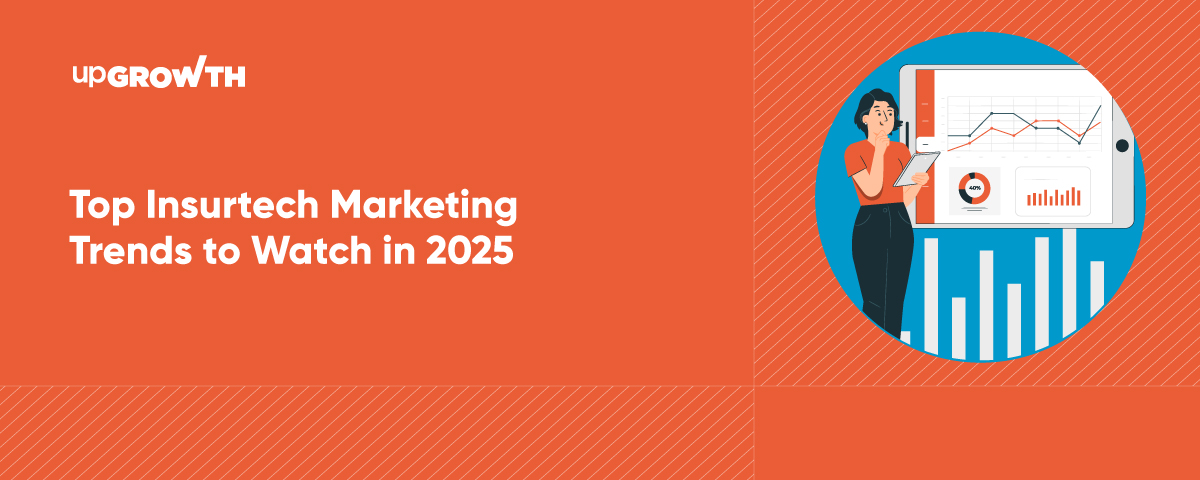Top Insurtech Marketing Trends to Watch in 2025
Contributors:
Subhashini Sakthivelu
Published: December 6, 2024

Summary
The InsurTech industry is undergoing dramatic transformation with the global protection gap projected to reach $1.86 trillion by 2025. From embedded insurance solutions expected to capture 25% of the market to AI innovations saving the industry $16 billion annually, emerging trends focus on digital transformation and customer-centricity. The shift toward parametric insurance, personalization, and sustainability reflects changing consumer demands, with 75% of customers preferring brands committed to sustainable practices. These innovations are reshaping how insurance products are marketed and delivered while addressing evolving customer needs in an increasingly digital marketplace.
The insurtech industry is evolving rapidly, driven by technological advancements and changing consumer expectations. As we look to 2025, understanding the global insurance market trends and specific insurance marketing trends becomes crucial for companies aiming to stay competitive. This blog explores the trends in insurtech, focusing on Embedded Insurance, Parametric Insurance, and P&C Insurance while providing insights that will shape the future of the insurance landscape.
How Is the Global Insurance Market Evolving?
The global protection gap—projected to reach $1.86 trillion by 2025—highlights the urgent need for innovative solutions in the insurance landscape. The global insurance market is witnessing a significant transformation characterised by several trends:
- Digital Transformation: Integrating digital technologies is reshaping how insurers operate, focusing on enhancing customer experience through digital platforms and automated processes.
- Consumer-Centric Models: Insurers are shifting from traditional product-centric approaches to models prioritising customer needs and preferences.
- Sustainability Initiatives: There is a growing emphasis on sustainability, with insurers developing products that address environmental risks and promote resilience against climate change.
What Are the Key Insurtech Trends for 2025?
In 2025, the insurtech space will witness several key trends redefining how insurance products are marketed and consumed. Here are the most significant trends in insurtech:
- Embedded Insurance
- Parametric Insurance
- Personalisation and Customer Experience
- Artificial Intelligence (AI) and Machine Learning (ML)
- Sustainability and ESG Factors
1. Why Is Embedded Insurance Gaining Popularity?
Embedded Insurance refers to integrating insurance products into the purchasing process of another product or service. This trend allows consumers to buy insurance seamlessly at the point of sale without requiring separate policy purchases.
For instance, when booking a flight, travelers may automatically receive travel insurance, making coverage more accessible and convenient.
Companies like Lemonade and Trov offer embedded insurance options that allow users to purchase coverage directly through platforms they already use, such as e-commerce sites or travel booking platforms. Embedded insurance could account for up to 25% of the total insurance market in the coming years.
2. How Does Parametric Insurance Work?
Parametric Insurance provides coverage based on predetermined parameters, such as weather conditions or natural disasters, rather than traditional indemnity methods. For example, Hurricane insurance that pays out automatically when wind speeds reach a certain threshold is a classic case of parametric insurance.
This model reduces the claims processing time and increases customer satisfaction. A study by the World Bank indicates that parametric insurance can reduce the time it takes to deliver aid after disasters by 30%.
3. What Role Does Personalization Play in Insurtech Marketing?
As consumers increasingly seek tailored experiences, personalisation in insurance marketing becomes vital. Insurtech companies leverage data analytics to offer customised products that meet individual needs.
Customer data can be utilised to create specific marketing campaigns that address unique life stages or situations, such as home ownership, marriage, or parenthood, which can enhance engagement. Zego, a UK-based insurtech, personalises its offerings for gig economy workers based on their driving habits and usage patterns.
4. How Are AI and ML Transforming the Insurtech Landscape?
Integrating Artificial Intelligence and Machine Learning into insurtech revolutionises underwriting, claims processing, and customer service. Insurers like Allstate and Progressive are employing AI to analyse vast amounts of data for better risk assessment and fraud detection.
AI could save the insurance industry up to $16 billion annually by improving operational efficiencies and reducing claims costs.
5. Why Is Sustainability Important in Insurance?
Sustainability is becoming a significant consideration for consumers and businesses alike in insurance marketing trends. Insurtech companies increasingly focus on Environmental, Social, and Governance (ESG) factors in their strategies.
Lemonade has integrated social impact into its business model, pledging to donate a portion of its profits to causes chosen by policyholders. 75% of consumers prefer to engage with brands that demonstrate a commitment to sustainability.
What Are the Emerging Marketing Strategies in Insurtech?
As the insurtech landscape evolves, so do the marketing strategies employed to reach potential customers. Here are some effective marketing strategies to watch in 2025:
Content Marketing for Engagement
- Content marketing remains a powerful tool for educating and engaging potential customers.
- Creating informative articles, infographics, and videos about insurance products can help demystify complex topics and establish authority.
- The Zebra utilises engaging blog content to explain insurance concepts and drive traffic to their insurance comparison platform.
Social Media Play in Insurtech Marketing
- Social media platforms are essential for building brand awareness and engaging directly with consumers.
- Insurtech companies can use targeted ads on platforms like Facebook and Instagram to reach specific demographics, especially younger consumers looking for flexible insurance options.
- 48% of consumers are more likely to purchase after engaging with a brand on social media.
Email Marketing on Customer Retention
- Email marketing continues to be an effective strategy for nurturing leads and retaining customers.
- Sending personalised emails with valuable content, policy updates, and renewal reminders can keep your brand top-of-mind for consumers.
- Personalised email campaigns can generate up to 6 times higher transaction rates.
Customer Feedback
- Collecting and analysing customer feedback is crucial for improving products and services.
- Utilising surveys and reviews can provide insights into customer satisfaction and areas for improvement.
- For example, Oscar Health actively solicits user feedback to refine their healthcare insurance offerings, which has resulted in higher customer satisfaction ratings.
What Are the Implications of These Trends for Insurers?
Enhanced Customer Relationships: Insurers must prioritize building deeper relationships with customers by focusing on personalized interactions and understanding individual needs. This involves leveraging data analytics to gain insights into customer behavior and preferences.
Sustainability as a Core Strategy: With growing consumer demand for sustainable practices, insurers are increasingly expected to incorporate environmental considerations into their business models. This includes offering products that promote resilience against climate-related risks.
Adapting to Regulatory Changes: As regulations evolve, insurers must remain agile in their operations. Compliance with new standards will require ongoing investment in technology and processes that enhance transparency and accountability.
How Can Insurers Leverage These Trends for Competitive Advantage?
To remain competitive in this rapidly changing landscape, insurers should consider the following strategies:
- Invest in Technology: Embrace innovations such as AI, blockchain, and IoT to streamline operations and enhance customer experiences.
- Prioritize Data Security: As reliance on digital platforms increases, ensuring robust data protection measures will be critical for maintaining consumer trust.
- Foster Partnerships: Collaborating with tech companies can facilitate the development of embedded insurance solutions and enhance product offerings.
Conclusion
The insurtech landscape is poised for significant transformation by 2025, driven by technological advancements and shifting consumer expectations. By proactively adapting to these changes, insurers can secure a competitive edge while addressing the evolving needs of their customers in an increasingly complex market.
At upGrowth, we are committed to empowering businesses to reach their full potential through innovative growth strategies. If you’re ready to take your business to the next level, explore our tailored solutions today!
FAQs
How is the rise of embedded insurance transforming marketing strategies within the insurtech sector?
The rise of embedded insurance is shifting marketing strategies to focus on seamless integration within customer journeys. Insurers are now promoting coverage as a natural part of purchasing experiences, enhancing convenience and accessibility for consumers.
What innovations in parametric insurance are influencing marketing trends?
Parametric insurance innovations, such as automated payouts based on predefined triggers, are influencing marketing trends by emphasizing transparency and speed. Marketers are highlighting these features to attract consumers seeking quick and hassle-free claims processes.
Can you describe the marketing implications of the latest trends in Property and Casualty (P&C) Insurance?
The latest trends in P&C insurance, such as usage-based pricing and AI-driven underwriting, are prompting marketers to emphasize personalization and data-driven solutions. This shift allows insurers to target specific customer segments more effectively and enhance engagement.
How are insurtech companies leveraging new technologies to enhance their marketing efforts?
Insurtech companies are leveraging technologies like AI, machine learning, and data analytics to refine their marketing efforts. These tools enable personalized messaging, improved customer insights, and more efficient targeting, ultimately driving better conversion rates.
How is customer experience being transformed by insurtech marketing trends?
Insurtech marketing trends are transforming customer experience by prioritizing digital engagement and self-service options. Enhanced mobile apps and user-friendly portals allow customers to manage policies and claims easily, leading to higher satisfaction levels.
What challenges do insurtech firms face when trying to adopt these emerging marketing trends?
Insurtech firms face challenges such as regulatory compliance, data privacy concerns, and the need for significant technological investments. Additionally, educating consumers about new products and services can be a hurdle in gaining market acceptance.
How do regulatory changes impact the marketing strategies of insurtech companies?
Regulatory changes can significantly impact insurtech marketing strategies by imposing new compliance requirements and restrictions on advertising. Insurers must adapt their messaging and promotional tactics to align with evolving regulations while ensuring transparency and trust.
About the Author
Copywriter
Subhashini Sakthivelu is a copywriter at upGrowth, where she plays a pivotal role in leading and executing impactful marketing projects. With a background in various marketing positions at prominent companies, Subhashini brings a wealth of expertise in crafting compelling content that drives engagement. Her strategic thinking and creativity have contributed significantly to uG’s successful campaigns.
 Growth Strategy and Planning
Growth Strategy and Planning Inbound Growth
Inbound Growth Growth Hacking
Growth Hacking Search Engine Optimization
Search Engine Optimization Paid and Performance Marketing
Paid and Performance Marketing Social Media Marketing
Social Media Marketing AI-Driven Growth Strategy
AI-Driven Growth Strategy
 Growth Tools
Growth Tools Offers
Offers





















Leave a Reply